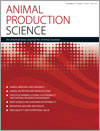
Animal Production Science
Volume 53 Number 3 2013
AN12048A review of potential contaminants in Australian livestock feeds and proposed guidance levels for feed
Contaminants present in feed can impact livestock production and may transfer to foods such as meat, milk and eggs. This paper summarises current knowledge of the potential for various contaminants to affect livestock production and transfer to food. To assist management of contaminants, guidance levels are proposed for their presence in livestock feed.
AN12185Sheep grazing bladder clover (Trifolium spumosum L.) had similar productivity and meat quality to sheep grazing subterranean clover (Trifolium subterraneum L.)
An accession of bladder clover, a new species to agriculture, was selected for commercial release to farmers in Australia. As part of a duty-of-care assessment, we compared the productivity and health of sheep grazing the bladder clover with sheep grazing subterranean clover cultivar, a species that is commonly grown. There were no critical differences in liveweight change, wool growth, health and meat quality between sheep grazing the two clover species.
AN12130Controlling voluntary intake of molasses-based supplements in grazing cattle
Molasses supplements fed free-choice are often used to improve the nutrition of grazing cattle, but it is often difficult for farmers to achieve optimal intakes of supplement. Experiments showed that high concentrations of urea and phosphoric acid additives in the supplement provided wide control supplement intake. This technology improves the intake control and cost-effectiveness of molasses supplements in extensive grazing systems.
AN12107Effects of defoliation intensity at the first grazing of forage rape (Brassica napus L.) by dairy cattle on subsequent regrowth potential, total DM consumed, nutritive characteristics and nutrient selection
Regrowth summer forage crops are becoming a popular option in southern Australia; however, little is understood about grazing strategies at the first grazing to optimise subsequent regrowth. An experiment was conducted to determine the effect of different grazing regimes (high, medium and low defoliation intensity) at the first grazing on subsequent regrowth capability and nutritive characteristics of Winfred (Brassica napus L.). Results indicated that the optimum grazing management will vary depending on the seasonal growing conditions with high grazing intensity a better option under moisture stress conditions and more lax grazing when moisture stress is not limiting growth.
AN11347Diet supplementation with clinoptilolite improves energy status, reproductive efficiency and increases milk yield in dairy heifers
Reproductive efficiency, a key factor for dairy herds’ profitability, is affected by various factors such as milk yield, nutrition and health status. Clinoptilolite enhances energy status, increases milk yield and improves reproductive parameters of dairy cows when fed at 200 g/day. Its low cost, ease of administration and wide availability in conjunction with optimal cattle performance can render clinoptilolite a widely used feed additive.
AN12109Effect of high altitude on nutrient digestibility, rumen fermentation and basal metabolism rate in Chinese Holstein cows on the Tibetan plateau
Little is currently known about the effect of high altitude on rumen microbial fermentation, digestion and basal metabolic rate in Chinese Holstein cows. This study found that in Chinese Holstein cows on the Tibetan plateau, digestion and rumen fermentation were impaired, and basal metabolism rate was increased. A diet with a higher amount of energy and an improvement of forage quality are recommended for use in lactating dairy cows in high altitude areas to improve energy status and production response of cows.
AN12039Backgrounding lambs on saltbush provides an effective source of Vitamin E that can prevent Vitamin E deficiency and reduce the incidence of subclinical nutritional myopathy during summer and autumn
Saltbush is a native, salt-tolerant shrub that can provide an excellent source of the essential antioxidant, Vitamin E, for grazing livestock. This study has determined that allowing young sheep to graze saltbush-based pastures during summer can prevent vitamin E deficiency and reduce the incidence of the associated disease, nutritional myopathy, compared to sheep without access to green feed. These findings show how saltbush planted on saline land can be used in clean, green and ethical production systems to prevent vitamin E deficiency and potentially replace the need for synthetic Vitamin E supplementation.
AN12093Preliminary investigations indicate that the lack of growth in Indonesian goat consumption is linked to negative perceptions of goat meat
A survey of Makassar residents found they mainly bought goat for religious and birth ceremonies not for family or visitors, supporting this hypothesis. Four consumer segments identified were correlated with goat meat purchasing patterns but not correlated with demographic variables. The lack of growth in goat meat consumption appears to be linked to negative perceptions about its effects on health.
AN12083Guanidination procedure increases standardised ileal digestibilities of nitrogen and amino acids in rapeseed meal, soybean meal and peas fed to growing pigs
The homoarginine method has been used to determine true ileal digestibilities of amino acids in feed ingredients for pigs but guanidination alters the amino acid composition of feed proteins. The study with pigs was conducted to assess the effect of guanidination in dietary sources of protein on standardised ileal digestibilities of nitrogen and amino acids. The study showed that guanidination increased the standardised ileal digestibilities of most amino acids in dietary source of protein.



